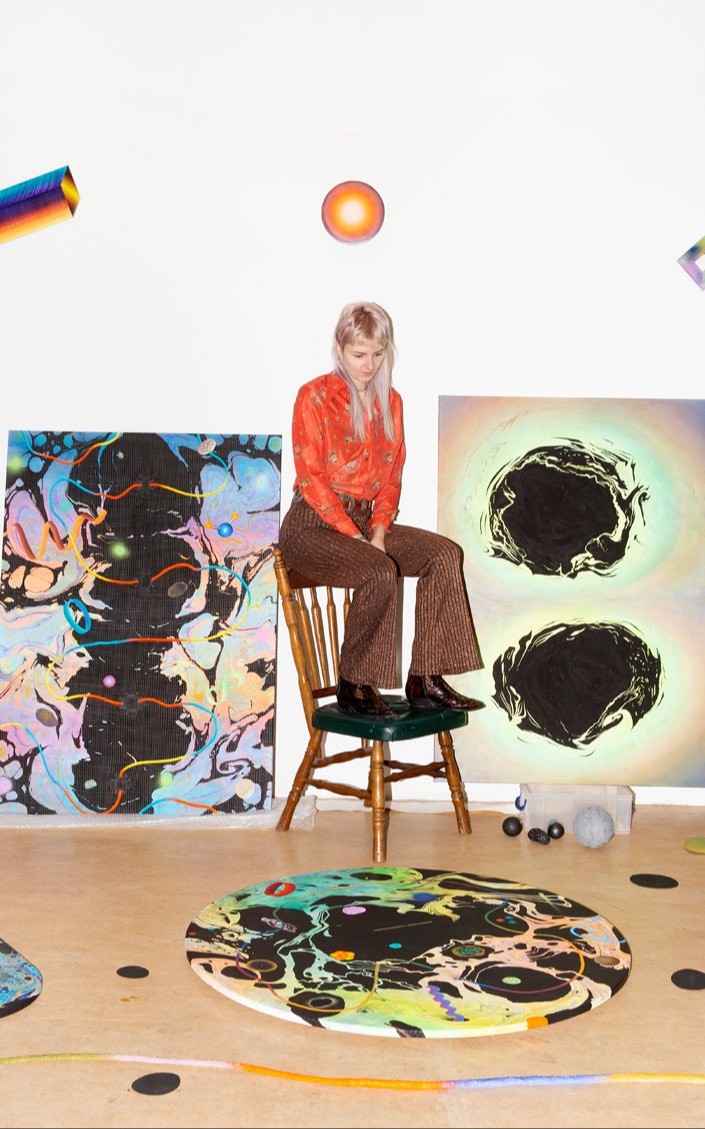[English text below Dutch]
Abstracte schilderijen en installaties die patronen, krachten en structuren verbeelden zijn voor Simone Albers een middel op onze binding met de natuur beter te begrijpen. Middels verschillende vormen van natuurwetenschap, zoals evolutionaire biologie, geologie en astronomie, zoomt zij zo ver mogelijk in om de natuurlijke wereld in kaart te brengen. De studie van organische, complexe en mysterieuze processen leiden tot filosofische vragen die terugkomen in de schilderijen en installaties van Simone: Hoe verhouden wij ons tot de natuur? En zullen we ooit antwoorden krijgen op de grote levensvragen?
Simone bestudeert tijdens Socials Aspects technieken en materialen die niet gebruikelijk voor haar zijn; ze gebruikt het project om te experimenteren met nieuwe vormen en ideeën. Daarbij verkent ze de historische plekken van Nijmegen, zoals de middeleeuwse kelders of de torens van de oude stadsmuren. Deze plekken, die de rijke geschiedenis van Nijmegen bij zich dragen, bieden ook een leefomgeving voor verschillende organismen die de basis vormen voor Simone’s studie. Door haar artistieke blik te laten verruimen door het wetenschappelijk veld, experimenteert ze met microbiologie in de Nijmeegse omgeving. Deze samenwerking leidt tot verrassende inzichten en objecten, die deel uitmaken van haar presentatie tijdens Social Aspects.
Op 12 juni presenteerde Simone Albers samen met Richard Bolhuis en Hans-Hannah ACT 1. Hier gingen zij onder begeleiding van archeoloog Marieke Helsen en chemicus Frans Eppink de Ooijpolder in, voor een wandeling die eindigde bij een paviljoen-in-progress. De middag stond in het teken van de relatie die de mens heeft met de gecultiveerde natuur en de historie en totstandkoming van de Ooij.
Abstract paintings and installations that depict patterns, forces and structures are a means for Simone Albers to get a better understanding of our bond with nature. Using various forms of natural science, such as evolutionary biology, geology and astronomy, she zooms in as far as possible to map the natural world. The study of organic, complex and mysterious processes leads to philosophical questions that recur in Simone's paintings and installations: How do we relate to nature? And will we ever get answers to life's big questions?
During Socials Aspects, Simone studies techniques and materials that are not usual for her; she uses the project to experiment with forms and ideas. She explores the historic sites of Nijmegen, such as the medieval cellars or the towers of the old city walls. These places, which carry the rich history of Nijmegen, also provide a habitat for various organisms that form the basis for Simone's study. By extending her artistic perspective into the scientific field, she experiments with microbiology in the Nijmegen environment. This collaboration leads to surprising insights and objects, which are part of her presentation during Social Aspects.
On June 12, Simone Albers presented ACT 1 together with Richard Bolhuis and Hans-Hannah. They entered the Ooijpolder under the guidance of archaeologist Marieke Helsen and chemist Frans Eppink, for a walk that ended at a pavilion-in-progress. The afternoon was devoted to the relationship that humans have with cultivated nature and the history and development of the Ooij.












